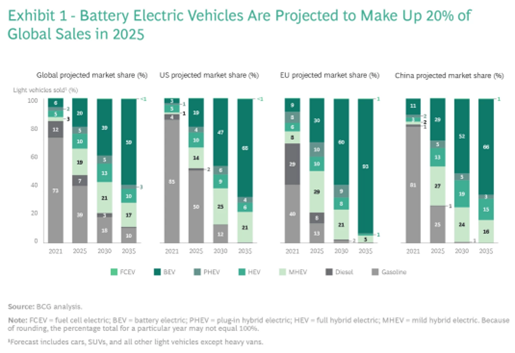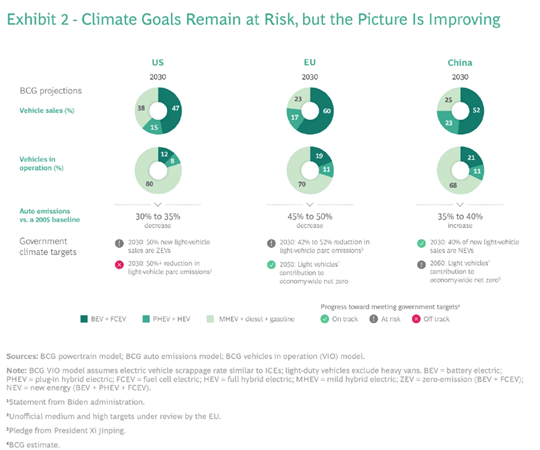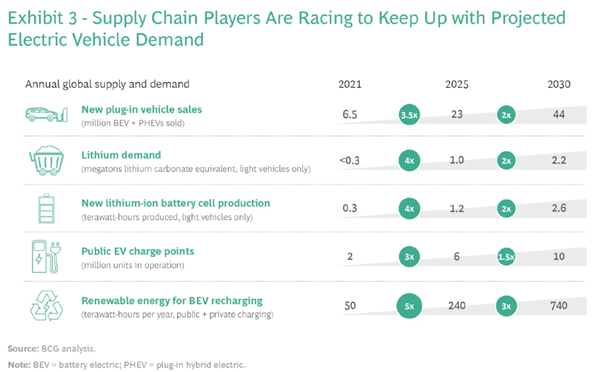Researchers Nathan Niese, Aakash Arora, Elizabeth Dreyer, Aykan Gökbulut, and Alex Xie, from the Boston Consulting Group, published an article in BCG Climate & Sustainability on june 2022, regarding electric cars adoption. The article provides an up- to-date review on this issue. Here are some of the key issues.
The world stands on the threshold of a new age of electrified mobility thanks to developments over the past year. Spurred by a renewed sense of urgency, regulators in Europe and the US have set far more demanding goals for curbing greenhouse gas emissions from cars and light vehicles. Automakers have also raised their game and introduced electric vehicle (EV) options in every part of their product portfolios. Together, these forces are turbocharging the global market for EVs.
The impact of these developments on sales of EVs will be dramatic. According to the author’s forecast, pure battery electric vehicles (BEVs) will be the most popular type of light vehicle sold globally in 2028—three years earlier than authors projected in their 2021 report on electric cars.

Several factors explain the strong showing. The regulatory pressures curbing the use of fossil-fuel-powered vehicles have increased in major Western markets. In the US, the Biden administration significantly tightened rules on tailpipe emissions.
And for much of the world’s population, EVs are heading toward purchasing-price parity with traditional ICE vehicles—a more important indicator of consumers’ car-buying behavior than TCO—by the end of the decade. The continuing decline in battery prices, which make up 30% to 40% of an EV’s cost of goods sold, is one factor leading to lower ownership costs. But so too are greater economies of scale due to increased production of EVs.
An Industry in Transition
The study stresses that the future of the automotive industry is electric. The researchers expect BEVs to account for 20% of global light-vehicle sales in 2025 and 59% in 2035. By comparison, in 2021 year’s report, they projected a BEV market share of 11% in 2025 and 45% in 2035.
All told, savvy automakers—both incumbent and new age—are recognizing that the shift to EVs significantly boosts the size of the profit pools available to the automotive industry.
Finally, operators of new autonomous-vehicle (AV) fleets are also opting for vehicles with electric power trains, given the emissions regulations and lower per-mile cost of these vehicles compared with ICE-powered cars.
Improved Progress on Climate Goals
By preparing to stop the sale of new fossil-fuel cars from 2035 (the ban should become legally binding next year or in 2024), the European Union is on track to achieve its goal of net-zero CO2 emissions in its “car parc”—the total stock of vehicles in use—by 2050, provided the bloc also continues to invest in mass-transit systems and clean-mobility options such as e-bikes.
Given that EVs accounted for more than 20% of new light-vehicle sales in China earlier this year, researchers expect that country to meet its 2030 target for 40% of vehicles sold to be pure electric. All new light-vehicle sales in China will need to be EVs by 2040 for the nation to achieve its 2060 net-zero goal.
The US, however, will require a major catch-up to hit its targets. The researchers believe that a window of opportunity still exists for the country to meet its objective for all new vehicles sold in 2030 to be zero emission the US car parc is unlikely to turn over rapidly enough for the administration to achieve its stated goal of a 50% reduction in economy-wide emission by 2030 versus a 2005 baseline. The US will also need to ban sales of new vehicles other than zero-emission ones by 2035—just as Europe is doing—to fulfill its 2050 net-zero pledge.

Some Remaining Risks to EV Adoption
Although the transition to electrified mobility is quickly gathering momentum, the authors have identified two short-term supply risks that could limit the rate of industry change—or spur greater innovation as players seek to overcome these obstacles. First, a supply shortage has emerged during the past half year in the metals needed to make EV batteries, including lithium and nickel.
Second, insufficient charging infrastructure over the next few years could cause EV adoption to stall in leading markets such as the US, especially in cities like Boston.

Demand for lithium, for example, is expected to shoot up by a CAGR of more than 25% from now until 2030. But post pandemic supply chain constraints, rising energy costs, and accelerated EV growth have already increased the price of the lithium compounds used for battery production—and are set to push up average battery costs after years of steady declines. Meanwhile, war and economic sanctions have raised nickel prices and threaten to exacerbate shortages of the metal.
Closing supply gaps in these metals, and curbing price increases, will depend on producers developing new production sites to meet rising demand. But the study points out that achieving this will not be easy because of the long lead times required to establish new production projects. As long as supply gaps persist, they could hamper the buildout of additional battery production capacity, hinder efforts to improve the battery range and lifespan of technologies, and delay—or even reverse—the declines in EV ownership costs.
A shortage of charging points in some countries looks set to worsen in the near future. In the UK, the automotive industry organization recently highlighted that current EV sales far outpace the growth in public charging stations. In the US, 1.1 million public charging sites will be needed in 2025 and 2.3 million in 2030, up from 100,000 in 2020, according to our analysis. The Biden administration is targeting only 500,000 public charging points by 2026, and the US Infrastructure Investment and Jobs Act is likely to fund less than one-tenth of these—leaving the private sector and state governments to fill the gap.
But concern about a lack of public charging sites is already the leading reason for US consumers to think twice about buying an EV, according to a recent survey from Consumer Reports, a nonprofit consumer organization.
A New Game
Coordinated action will be essential to overcome the challenges outlined. The researchers stress that there is a reason to work together, instead of treating the development of viable solutions as a zero-sum game of winners and losers.
In the charging space, a raft of players is helping to accelerate the rollout of publicly available chargers. Governments are freeing up land and supporting ambitious projects such as wireless EV charging. Manufacturers are creating prefabricated charging sites to shorten installation times. And automakers and utilities are jointly working on pilots to add network capacity and flexibility so that EV owners can use their vehicles for home charging or to sell surplus power back to the grid. As EV-specific electricity rates, smarter vehicle architectures, and common standards are introduced, the cost of EV charging looks set to fall.
What these actions show is that—when confronted with significant challenges— the automotive industry is quick to innovate. The proof: leading automakers today are still delighting customers and creating value for shareholders. But they are also setting an example for other sectors on how to respond to the climate change challenge. The authors expect far greater innovation to emerge as automakers establish electrification as the dominant mobility technology. Strap in as the industry goes full speed ahead toward a zero-emission future.